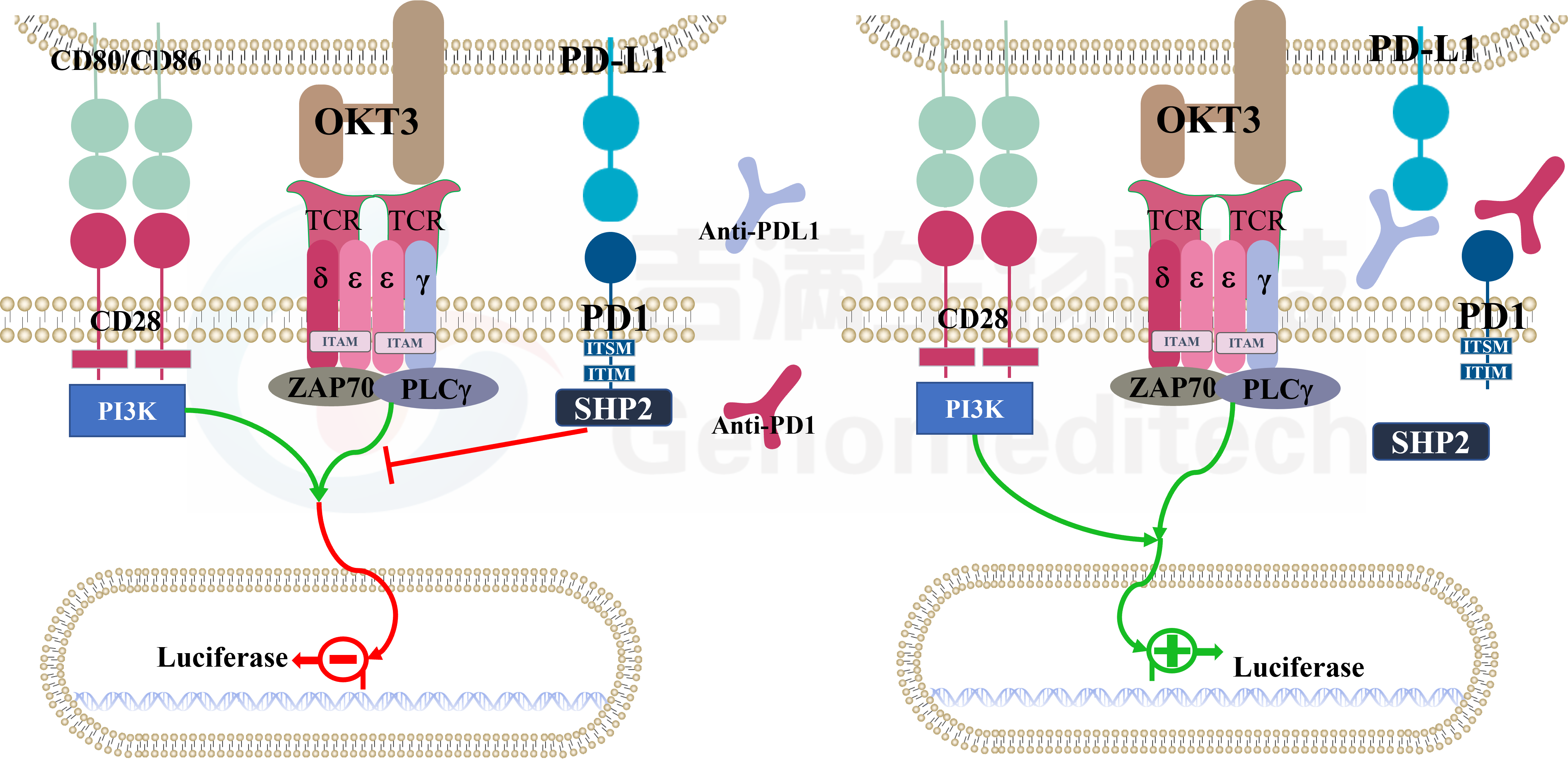Cat. No:GM-032AS005
Product:H_PD-1 PDL1 Reporter Blockade Assay (CHO-aAPC)

Cat. No:GM-032AS005
Product:H_PD-1 PDL1 Reporter Blockade Assay (CHO-aAPC)

H_PD-1 Reporter Jurkat Cell Line
Cell Growth Medium:RPMI 1640+10% FBS+1% P.S+3.5 μg/mL Blasticidin+0.75 μg/mL Puromycin
Cell Freezing Medium:90% FBS+10% DMSO
aAPC(OKT3) PDL1 CHO-K1 Cell Line
Cell Growth Medium:F12K+10% FBS+1% P.S +4 μg/mL Blasticidin+4 μg/mL Puromycin
Cell Freezing Medium:90% FBS+10% DMSO
Assay Buffer:RPMI 1640+1% FBS+1% P.S
PD-1 is an immune inhibitory receptor expressed by activated T and B cells, playing a crucial role in regulating immune responses to tumor antibodies and self-antigens. Interaction between PD-1 on neighboring cells and its ligands PD-L1 or PD-L2 inhibits the transmission of the TCR signaling pathway, as well as TCR-mediated cell proliferation, transcription activation, and cytokine production. Therapeutic antibodies and Fc fusion proteins blocking the PD-1/PD-L1 interaction have shown promising applications in clinical trials for various cancers.
Current methods for evaluating the activity of anti-PD-1 or anti-PD-L1 biologics rely on measuring primary human T cell and functional endpoints, such as cell proliferation, expression of cell surface markers, interferon-gamma (IFNγ) and interleukin-2 (IL-2) production. These assays are labor-intensive and prone to variability due to reliance on donor-derived primary cells, complex assay protocols, and substandard test reagents, making them difficult to establish in a quality-controlled drug development environment.
The H_PD-1 PDL1 Reporter Blockade Assay (CHO-aAPC) is a biologically relevant, mechanism of action-based method for assessing the efficacy and stability of antibodies and other biologics that block the PD-1/PD-L1 interaction. This assay involves two genetically engineered cell lines: PD-1 effector cells, which are Jurkat T cells stably expressing the human PD-1 receptor and NFAT-induced luciferase reporter gene; and PD-L1 aAPC/CHO-K1 cells, a CHO-K1 cell line stably expressing human PD-L1 and a cell surface protein that activates a homologous TCR in an antigen-independent manner.
When these two cell types are co-cultured, the interaction between PD-1/PD-L1 inhibits the transduction of the TCR signaling pathway and NFAT-mediated luciferase expression. Addition of antibodies blocking PD-1/PD-L1 reverses this inhibition, leading to the transmission of the TCR signaling pathway and NFAT-mediated luciferase expression.
Cat. No:GM-032AS005
Product:H_PD-1 PDL1 Reporter Blockade Assay (CHO-aAPC)

H_PD-1 Reporter Jurkat Cell Line
Cell Growth Medium:RPMI 1640+10% FBS+1% P.S+3.5 μg/mL Blasticidin+0.75 μg/mL Puromycin
Cell Freezing Medium:90% FBS+10% DMSO
aAPC(OKT3) PDL1 CHO-K1 Cell Line
Cell Growth Medium:F12K+10% FBS+1% P.S +4 μg/mL Blasticidin+4 μg/mL Puromycin
Cell Freezing Medium:90% FBS+10% DMSO
Assay Buffer:RPMI 1640+1% FBS+1% P.S
PD-1 is an immune inhibitory receptor expressed by activated T and B cells, playing a crucial role in regulating immune responses to tumor antibodies and self-antigens. Interaction between PD-1 on neighboring cells and its ligands PD-L1 or PD-L2 inhibits the transmission of the TCR signaling pathway, as well as TCR-mediated cell proliferation, transcription activation, and cytokine production. Therapeutic antibodies and Fc fusion proteins blocking the PD-1/PD-L1 interaction have shown promising applications in clinical trials for various cancers.
Current methods for evaluating the activity of anti-PD-1 or anti-PD-L1 biologics rely on measuring primary human T cell and functional endpoints, such as cell proliferation, expression of cell surface markers, interferon-gamma (IFNγ) and interleukin-2 (IL-2) production. These assays are labor-intensive and prone to variability due to reliance on donor-derived primary cells, complex assay protocols, and substandard test reagents, making them difficult to establish in a quality-controlled drug development environment.
The H_PD-1 PDL1 Reporter Blockade Assay (CHO-aAPC) is a biologically relevant, mechanism of action-based method for assessing the efficacy and stability of antibodies and other biologics that block the PD-1/PD-L1 interaction. This assay involves two genetically engineered cell lines: PD-1 effector cells, which are Jurkat T cells stably expressing the human PD-1 receptor and NFAT-induced luciferase reporter gene; and PD-L1 aAPC/CHO-K1 cells, a CHO-K1 cell line stably expressing human PD-L1 and a cell surface protein that activates a homologous TCR in an antigen-independent manner.
When these two cell types are co-cultured, the interaction between PD-1/PD-L1 inhibits the transduction of the TCR signaling pathway and NFAT-mediated luciferase expression. Addition of antibodies blocking PD-1/PD-L1 reverses this inhibition, leading to the transmission of the TCR signaling pathway and NFAT-mediated luciferase expression.